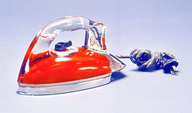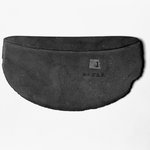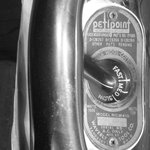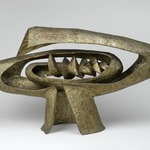

Saunders Corporation (ca. 1858–1946). "Silver Streak" Iron, ca. 1946. Pyrex glass, metal, cloth and plastic, 5 1/2 x 9 1/4 x 3 7/8 in. (14.0 x 23.5 x 9.9 cm). Brooklyn Museum, Gift of Donald F. Wilkes, 1992.167. Creative Commons-BY (Photo: Brooklyn Museum, CUR.1992.167.jpg)

Saunders Corporation (ca. 1858–1946). "Silver Streak" Iron, ca. 1946. Pyrex glass, metal, cloth and plastic, 5 1/2 x 9 1/4 x 3 7/8 in. (14.0 x 23.5 x 9.9 cm). Brooklyn Museum, Gift of Donald F. Wilkes, 1992.167. Creative Commons-BY (Photo: Brooklyn Museum, 1992.167_PS11.jpg)
"Silver Streak" Iron
Decorative Arts and Design
On View: Decorative Art, 4th Floor
Although Pyrex glass, able to resist high levels of heat, had been invented as long ago as 1915, the Silver Streak iron put it to a new use. Metal shortages during World War II led to experiments not only with new materials, but also with new uses of old materials. Pyrex seemed the perfect replacement for metal in a household iron. Moreover, moldable glass allowed the handle of the Silver Streak to conform to the user’s hand, illustrating again the interest in ergonomics—the study of the way things work with the body—among designers of this time. Unfortunately, although Pyrex stood up well to heat, the bright colors inside did not, and the Silver Streak was not produced for very long.
MANUFACTURER
Saunders Corporation, ca. 1858–1946
MEDIUM
Pyrex glass, metal, cloth and plastic
DATES
ca. 1946
DIMENSIONS
5 1/2 x 9 1/4 x 3 7/8 in. (14.0 x 23.5 x 9.9 cm) (show scale)



MARKINGS
(1) Impressed on top side of metal heel: [in script] "Silver Streak"
(2) Impressed on bottom side of metal heel: "SAUNDERS SINCE 1858 / MODEL 1038 / 1000 WATTS / 110-120 VOLTS A.C. ONLY"
(3) Molded in Pyrex below handle: "PYREX"
COLLECTIONS
Decorative Arts and Design
ACCESSION NUMBER
1992.167
CREDIT LINE
Gift of Donald F. Wilkes
CATALOGUE DESCRIPTION
"Silver Streak" electric iron; glass and metal. Molded Pyrex body, red cased with colorless glass. Colorless glass handle joined at both ends. Circular metal and plastic dial with fabric selection mounted on torso under handle. Black and white cloth covered cord and black plastic plug.
CONDITION: Excellent; cord and plug intact. Light scratches on metal base and underside.
MUSEUM LOCATION
This item is on view in Decorative Art, 4th Floor
CAPTION
Saunders Corporation (ca. 1858–1946). "Silver Streak" Iron, ca. 1946. Pyrex glass, metal, cloth and plastic, 5 1/2 x 9 1/4 x 3 7/8 in. (14.0 x 23.5 x 9.9 cm). Brooklyn Museum, Gift of Donald F. Wilkes, 1992.167. Creative Commons-BY (Photo: Brooklyn Museum, CUR.1992.167.jpg)
IMAGE
overall, CUR.1992.167.jpg. Brooklyn Museum photograph, 2010
"CUR" at the beginning of an image file name means that the image was created by a curatorial staff member. These study images may be digital point-and-shoot photographs, when we don\'t yet have high-quality studio photography, or they may be scans of older negatives, slides, or photographic prints, providing historical documentation of the object.
RIGHTS STATEMENT
Creative Commons-BY
You may download and use Brooklyn Museum images of this three-dimensional work in accordance with a Creative Commons license. Fair use, as understood under the United States Copyright Act, may also apply.
Please include caption information from this page and credit the Brooklyn Museum. If you need a high resolution file, please fill out our online application form (charges apply).
For further information about copyright, we recommend resources at the United States Library of Congress, Cornell University, Copyright and Cultural Institutions: Guidelines for U.S. Libraries, Archives, and Museums, and Copyright Watch.
For more information about the Museum's rights project, including how rights types are assigned, please see our blog posts on copyright.
If you have any information regarding this work and rights to it, please contact copyright@brooklynmuseum.org.
RECORD COMPLETENESS
Not every record you will find here is complete. More information is available for some works than for others, and some entries have been updated more recently. Records are frequently reviewed and revised, and we welcome any additional information you might have.







































